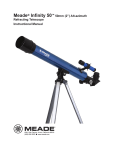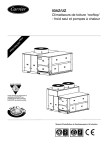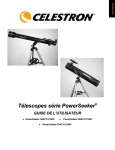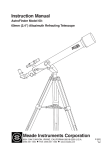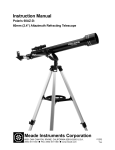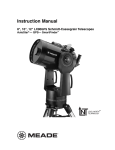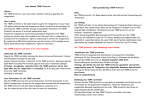Download Meade 50 AZ-T Instruction manual
Transcript
Instruction Manual Meade 50AZ-P 50mm (2”) Altazimuth Refracting Telescope 27 Hubble, Irvine, California 92618 (800) 626-3233 www.meade.com Looking at or near the Sun will cause irreversable damage to your eye. Do not point this telescope at or near the Sun. Do not look through the telescope as it is moving. 1 WARNING Never use an 50AZ-P Telescope to look at the Sun! Looking at or near the Sun will cause instant and irreversible damage to your eye. Eye damage is often painless, so there is no warning to the observer that damage has occurred until it is too late. Do not point the telescope or its viewfinder at or near the Sun. Do not look through the telescope or its viewfinder as it is moving. Children should always have adult supervision while observing. Limited Warranty Every telescope and telescope accessory is warranted by Meade Instruments Corporation (“Meade”) to be free of defects in materials and workmanship for a period of ONE YEAR from the date of original purchase in the U.S.A. Meade will repair or replace a product, or part thereof, found by Meade to be defective, provided the defective part is returned to Meade, freight-prepaid, with proof of purchase. This warranty applies to the original purchaser only and is non-transferable. Meade products purchased outside North America are not included in this warranty, but are covered under separate warranties issued by Meade international distributors. RGA Number Required: Prior to the return of any product or part, a Return Goods Authorization (RGA) number must be obtained from Meade by writing, or by calling (800) 626-3233. Each returned part or product must include a written statement detailing the nature of the claimed defect, as well as the owner’s name, address, and phone number. This warranty is not valid in cases where the product has been abused or mishandled, where unauthorized repairs have been attempted or performed, or where depreciation of the product is due to normal wearand-tear. Meade specifically disclaims special, indirect, or consequential damages or lost profit which may result from a breach of this warranty. Any implied warranties which cannot be disclaimed are hereby limited to a term of one year from the date of original retail purchase. This warranty gives you specific rights. You may have other rights which vary from state to state. Meade reserves the right to change product specifications or to discontinue products without notice. This warranty supersedes all previous Meade product warranties. 2 Looking at or near the Sun will cause irreversable damage to your eye. Do not point this telescope at or near the Sun. Do not look through the telescope as it is moving. TABLE OF CONTENTS Introduction 5 Standard Equipment 5 Unpacking and Assembly 5 Viewfinder Focusing and Alignment 6 Using the Telescope 6 Calculating Power 7 A Few Words About Power 8 Maintenance 8 Specifications 8 Optional Accessories 8 Looking at or near the Sun will cause irreversable damage to your eye. Do not point this telescope at or near the Sun. Do not look through the telescope as it is moving. 3 B e C 1& g D 1% 2! F 1@ 2@ H 1# 1! 1^ 2) 1$ I 1( 1* j 1) Fig. 1: Meade 50AZ-P 2” Altazimuth Refracting Telescope 1. Eyepiece 12. Optical-tube-to-mount attachment point 2. 5 x 24 Viewfinder 13. Optical-tube-to-mount attachment knob 3. Viewfinder bracket 14. Optical-tube-to-mount locking knob 4. Viewfinder collimation screws 15. Diagonal mirror 5. Optical tube assembly 16. Objective lens and lens cell (inside tube) 6. Viewfinder bracket attaching nuts 17. Eyepiece holder and thumbscrew 7. Altitude locking control handle 18. Sliding leg extension locking collar 8. Tripod legs 19. Adjustable sliding center leg extension 9. Leg brace supports 20. Dew shield/lens shade 10. Accessory tray 21. Front lens cap 11. Altazimuth mount 22. Focusing knob 4 Looking at or near the Sun will cause irreversable damage to your eye. Do not point this telescope at or near the Sun. Do not look through the telescope as it is moving. INTRODUCTION Before you begin your visual journey, we urge you to take a few minutes to completely read this manual so that you can get the best use of the equipment. This manual details the setup, operation, specifications, and optional accessories of the Meade 50AZ-P Altazimuth Refracting Telescope. The Meade 50AZ-P is designed for both astronomical and terrestrial observing. Whether you are observing objects a few meters away or light years distant, the Meade 50AZ-P’s precision optics and sturdy mount are the tools with which you can learn basic telescope skills that can lead to a lifetime of enjoyment and discovery. STANDARD EQUIPMENT (Refer to Fig. 1) • Complete optical tube assembly with 50mm-diameter, 625mm focal length, coated objective lens; dew shield; 5 x 24 viewfinder with bracket; rack-and-pinion focuser. • Altazimuth mount with pre-attached continuously-adjustable steel tripod and leg braces. • Altitude locking control handle. • Accessories: Wide-field H 25mm (25X), H 12.5mm (50X) eyepieces (.965” O.D. “Outside Diameter”) 3x Barlow lens Diagonal mirror (.965”) Viewfinder Accessory tray Autostar Suite astronomy software CD-Rom (separate instructions supplied with the software package) UNPACKING AND ASSEMBLY Note that although the telescope is unassembled, all of the more difficult or complicated sections of the instrument are already factory pre-assembled; first time assembly of the telescope should not require more than about 15 minutes. To set up the telescope, follow this procedure: 1. Remove and identify the telescope’s components, using the listing on page 3. 2. Spread the three tripod legs (8, Fig. 1) evenly apart and insert the accessory tray (10, Fig. 1) in the hole at the center of the leg brace supports (9, Fig. 1). 3. Snugly thread-in the altitude locking control handle (7, Fig. 1) into the altazimuth mount (11, Fig. 1) at the opticaltube-to-mount attachment point (12, Fig. 1). Thread-in the optical-tube-to-mount attaching knob (13, Fig. 1) until snug, and then tighten the optical-tube-to-mount lock knob (14, Fig. 1). 4. Attach the viewfinder (2, Fig. 1) and viewfinder bracket (3, Fig. 1) by unthreading the two viewfinder bracket attaching nuts (6, Fig. 1) that are located on the tube near the focuser and placing the viewfinder bracket (with the eyepiece-end of the viewfinder facing the focuser of the telescope) over the two protruding threaded studs. Then replace the two viewfinder bracket attaching nuts to secure the bracket to the optical tube. 5. Insert the diagonal mirror (15, Fig. 1) into the eyepiece holder (17, Fig. 1) and the wide-field H 25mm eyepiece (1, Fig. 1) into the diagonal mirror. Secure each in place with a moderate tightening of the respective thumbscrews. 6. Extend the sliding leg extension (19, Fig. 1) portion of the adjustable height tripod to the desired length on all three legs by rotating the sliding leg extension collar (18, Fig. 1) counterclockwise to release the inner sliding leg. When you achieve the desired height, lock the tripod leg by rotating the sliding leg extension collar clockwise until it is snug. Do not over-tighten the locking collars as they can become damaged. ALTAZIMUTH MOUNT MOVEMENTS AND LOCK The telescope can tilt just over 90° in altitude (the up-and-down movement) and rotate 360° in azimuth (the side-toside movement), hence the term “Altazimuth” in this telescope’s mount. The Altazimuth mount can be locked only in altitude, the azimuth movement is always free. Looking at or near the Sun will cause irreversable damage to your eye. Do not point this telescope at or near the Sun. Do not look through the telescope as it is moving. 5 To move the telescope on the mount, unlock the altitude locking control handle (7, Fig. 1) by turning the handle counterclockwise one complete turn. Hold the handle while moving the telescope in altitude and/or azimuth. When finished, lock the altitude control handle by tightening the handle, turning clockwise. Tip: By keeping the altitude locking handle slightly tight, the telescope can still be moved in altitude without running the risk of having the telescope “flip” in the up or down movement. VIEWFINDER FOCUSING AND ALIGNMENT The 5 x 24mm viewfinder (2, Fig. 1) is a low-power, wide-field sighting device that, once aligned, will allow you to point the telescope with greater precision. Take note that when you look through the viewfinder, you will see a crosshair with images that will be upside-down; this is normal. To work properly, the viewfinder must first be aligned to the telescope’s main optical tube. To align the viewfinder, follow these steps: 1. Remove the lens cap (21, Fig. 1) of the optical tube assembly. Place the H 25mm eyepiece in the diagonal mirror and point the optical tube assembly (5, Fig. 1) at some well-defined, distant land object (e.g. the top of a distant telephone pole). Note: Images are either backwards or upside-down, depending on the rotation angle of the diagonal mirror; this is normal. It is recommended that you choose an object that is as distant as possible, so that the viewfinder alignment will be accurate enough to point the telescope at individual planets and stars during astronomical observations. 2. Look through the viewfinder (2, Fig. 1) and tighten or loosen, as appropriate, the viewfinder bracket’s three collimation screws (4, Fig. 1), until the crosshairs of the viewfinder are precisely centered on the same object already centered in the telescope’s H 25mm eyepiece. When finished, tighten the viewfinder’s three collimation screws to a firm feel so that it remains in alignment. 3. Objects located in the 5 x 24mm viewfinder will now be centered in the telescope eyepiece. USING THE TELESCOPE With the telescope assembled, you are ready to begin observations. 1. First, pick out an easy-to-find object. Observing land objects during the daytime is a good way to become accustomed to the operation of the telescope. At night, try observing the Moon at first (if it is visible) or a bright star. 2. To center an object in the main telescope, first use the aligned viewfinder to find the object you wish to observe. If necessary, slightly loosen the altitude locking control handle (7, Fig. 1), to re-position the telescope so that the desired object can be centered in the viewfinder. When the object is centered in the viewfinder, it should then, also, be somewhere in the main telescope’s field of view. Next, using the 25mm eyepiece, center the object in the main telescope’s field of view, and sharply focus the image by turning the focus knob (22, Fig. 1). The wide-field H 25mm eyepiece included as standard equipment is the best eyepiece to use for the initial finding and centering of an object. The low-power H 25mm eyepiece presents a bright, wide field of view, ideal for terrestrial and general astronomical observing of star fields, clusters of stars, nebulae, and galaxies. For lunar and planetary viewing, switch to a higher power eyepiece such as the H 12.5mm – if you have good viewing conditions. If the image starts to become fuzzy as magnification is increased, back down to a lower power; The atmosphere is not steady enough to support higher powers. Note: Changing eyepieces changes power. 3. If you are observing an astronomical object (the Moon, a planet, star, etc.) you will notice that the object will begin to move slowly through the telescopic field of view. This movement is caused by the rotation of the Earth and makes an object appear to be moving in the telescope’s field of view. To keep astronomical objects centered in the field, simply move the telescope up or down, or side-to-side (vertical and/or horizontal), using the altitude control handle (7, Fig. 1) as appropriate. At higher powers, astronomical objects will seem to move through the field more rapidly. 4. Avoid touching the eyepiece while observing through the telescope. Vibrations resulting from such contact will cause the image to move. Avoid observing sites where vibrations may introduce image movement. Viewing from the upper floors of a building may also introduce image movement. 5. Allow a few minutes for your eyes to become “dark adapted” prior to attempting any serious observations. Use a red-filtered flashlight (you can make your own by taping red cellophane over a flashlight lens) to protect your night vision when reading star maps, or inspecting components of the telescope. 6 Looking at or near the Sun will cause irreversable damage to your eye. Do not point this telescope at or near the Sun. Do not look through the telescope as it is moving. 6. Avoid setting up the telescope inside a room and observing through a closed window pane. Images may appear blurred or distorted due to temperature differences between inside and outside air. Also, it is a good idea to allow your telescope a chance to reach the ambient (surrounding) outside temperature before starting an observing session. 7. We repeat the warning stated at the outset of this manual: NEVER POINT THE TELESCOPE DIRECTLY AT OR NEAR THE SUN AT ANY TIME! OBSERVING THE SUN, EVEN FOR THE SMALLEST FRACTION OF A SECOND, WILL RESULT IN INSTANT AND IRREVERSIBLE EYE DAMAGE, AS WELL AS PHYSICAL DAMAGE TO THE TELESCOPE ITSELF. 8. Planets and other objects viewed low on the horizon often lack sharpness — the same object, when observed higher in the sky, will appear sharper and have greater contrast. Turbulent air in the atmosphere can cause images to “shimmer” in the eyepiece. Try reducing power (change your eyepiece) until the image steadies. Keep in mind that a bright, clear, but smaller image is more interesting than a larger, dimmer, fuzzy one. 9. Astronomical software or a good star atlas will assist you in locating many interesting celestial objects. These objects include: • The Moon, covered with craters, mountain ranges, and fault lines. The Moon is best observed during its crescent or half phase when Sunlight strikes the Moon’s surface at an angle. It casts shadows and adds a sense of depth to the view. No shadows are seen during a full Moon, causing the bright Moon to appear flat and uninteresting. • Cloud belts across the surface of the planet Jupiter. • The 4 major moons of Jupiter, visible around the planet, changing position each night. • Saturn and its famous ring system. • Deep-Space: Nebulae, galaxies, multiple star systems, star clusters — hundreds of such objects are visible through the Meade 50AZ-P. • Terrestrial objects: Your Meade telescope may also be used for high-resolution land viewing. Important Note: Using that the diagonal mirror results in an image which is reversed left-for-right, but which is correctly oriented up-and-down. For a fully corrected image, the 35X erecting eyepiece (.965” O.D.) is required. Terrestrial observations should almost always be made using the 25mm low-power eyepiece for bright, sharp images. Observing horizontally through the Earth’s atmosphere distorts images in higher-power eyepieces (such as 12.5mm). 10. The T-18mm erecting eyepiece is also a stand-alone 14X microscope. To use, place the clear base on top of the object to be examined and look through the eyepiece. CALCULATING POWER The power, or magnification, at which a telescope is operating is determined by two factors: the focal length of the telescope’s main (objective) lens and the focal length of the eyepiece being used. The focal length of the Meade 50AZ-P’s objective lens is 625mm. To figure out the power you are using, divide the the focal length of the objective lens by the focal length of the eyepiece. For example, if you are using the H 25mm eyepiece with the Meade 50AZ-P, the resulting power will be: Power = 625mm ÷ 25mm = 25X. Similarly, if you are using the H 12.5mm eyepiece, the resulting power will be: 625mm ÷ 12.5mm = 50X. Note: The letter “H” refers to the “Huygens” optical design which yields well-corrected images with refracting telescopes. With the 3.5x Barlow lens, an eyepiece’s power is multiplied 3.5 times. For example, the H 25mm (25X) eyepiece, when used in conjunction with the 3.5x Barlow lens, produces a magnification of 88X. The H 12.5mm (50X) eyepiece produces a magnification of 175X when used with the Barlow lens. To use the 3.5x Barlow lens, remove the diagonal mirror from the eyepiece holder (17, Fig. 1), then insert the 3.5x Barlow lens, followed by the diagonal mirror (15, Fig. 1) and eyepiece (1, Fig. 1). Refocus until the image is sharp. Looking at or near the Sun will cause irreversable damage to your eye. Do not point this telescope at or near the Sun. Do not look through the telescope as it is moving. 7 A FEW WORDS ABOUT POWER The useful higher magnification with any 50mm diameter telescope is in the range of 50 to 100 power. The general rule to follow with any telescope, regarding power: Only use as much magnification as a steady, well-defined image supports. The stability of the air varies and is one reason why having various eyepieces is desirable. Higher powers are no guaranty of better images; in fact, the opposite is often true. MAINTENANCE As with any quality optical instrument, lens surfaces should be cleaned as infrequently as possible. A little dust on the surface of the objective lens causes negligible degradation of image quality and should not be considered reason to “clean” the lens. When lens cleaning does become necessary, use a camel’s hair brush or compressed air to gently remove dust. Wipe only with a soft, clean cloth, applying as little pressure as possible to avoid scratching glass surfaces. Note: Remove the dew shield/lens shade (20, Fig. 1) to access the objective lens (16, Fig. 1). SPECIFICATIONS Objective (main) lens focal length 625mm Objective lens diameter 50mm (2.0”) Focal ratio f/12.5 Mounting type Altazimuth, with locking pan-handle 3X Barlow Tray Dust Cover 27 Hubble, Irvine, California 92618 (800) 626-3233 www.meade.com 8 Looking at or near the Sun will cause irreversable damage to your eye. Do not point this telescope at or near the Sun. Do not look through the telescope as it is moving.








